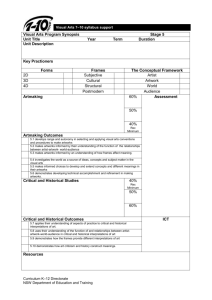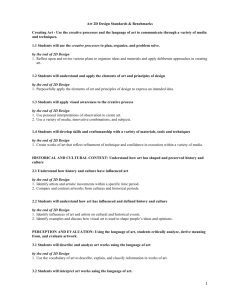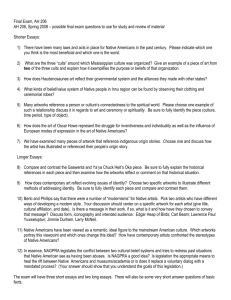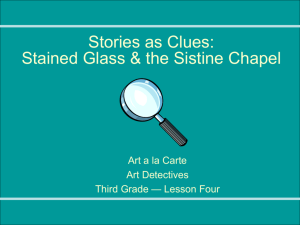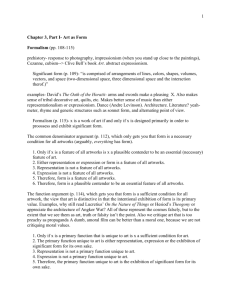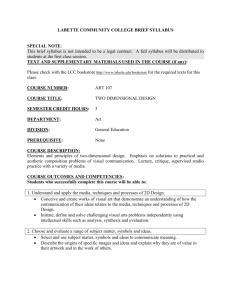10 - John Toth
advertisement
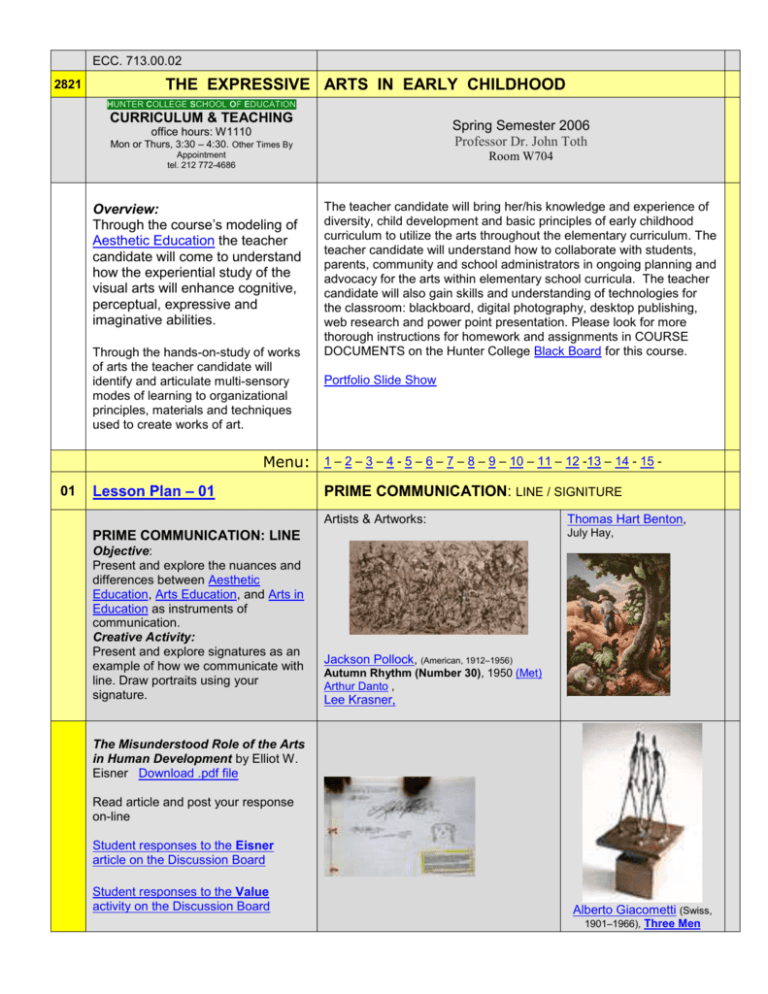
ECC. 713.00.02 2821 THE EXPRESSIVE ARTS IN EARLY CHILDHOOD HUNTER COLLEGE SCHOOL OF EDUCATION CURRICULUM & TEACHING Spring Semester 2006 Professor Dr. John Toth office hours: W1110 Mon or Thurs, 3:30 – 4:30. Other Times By Appointment tel. 212 772-4686 Room W704 Overview: Through the course’s modeling of Aesthetic Education the teacher candidate will come to understand how the experiential study of the visual arts will enhance cognitive, perceptual, expressive and imaginative abilities. Through the hands-on-study of works of arts the teacher candidate will identify and articulate multi-sensory modes of learning to organizational principles, materials and techniques used to create works of art. The teacher candidate will bring her/his knowledge and experience of diversity, child development and basic principles of early childhood curriculum to utilize the arts throughout the elementary curriculum. The teacher candidate will understand how to collaborate with students, parents, community and school administrators in ongoing planning and advocacy for the arts within elementary school curricula. The teacher candidate will also gain skills and understanding of technologies for the classroom: blackboard, digital photography, desktop publishing, web research and power point presentation. Please look for more thorough instructions for homework and assignments in COURSE DOCUMENTS on the Hunter College Black Board for this course. Portfolio Slide Show Menu: 1 – 2 – 3 – 4 - 5 – 6 – 7 – 8 – 9 – 10 – 11 – 12 -13 – 14 - 15 01 Lesson Plan – 01 PRIME COMMUNICATION: LINE / SIGNITURE Artists & Artworks: Objective: Present and explore the nuances and differences between Aesthetic Education, Arts Education, and Arts in Education as instruments of communication. Creative Activity: Present and explore signatures as an example of how we communicate with line. Draw portraits using your signature. Thomas Hart Benton, July Hay, PRIME COMMUNICATION: LINE Jackson Pollock, (American, 1912–1956) Autumn Rhythm (Number 30), 1950 (Met) Arthur Danto , Lee Krasner, The Misunderstood Role of the Arts in Human Development by Elliot W. Eisner Download .pdf file Read article and post your response on-line Student responses to the Eisner article on the Discussion Board Student responses to the Value activity on the Discussion Board Alberto Giacometti (Swiss, 1901–1966), Three Men Rubric for drawing activity LINE LANGUAGE Examples of student artworks 1, 2, 3, 4, 5, 6, 7, 8, 9, 10 Walking (II), 1949 (Met) 02 Lesson Plan - 02 TINTS & SHADES VALUE PAINTING: TINTS & SHADES Objective: Art communicates through a language of shades and tints: value is the lightness and darkness of color. Skills Activity: Paint a composition that uses at least eight shades and tints using black and white pigments. Creative Activity: Use the skills and control of mixing tines and shades to make a tonal study with tempra point with a theme of your choice. Artists & Artworks: Charles Demuth, Georgia O’Keefe, Alberto Giacometti (Swiss, 1901–1966), The Artists Wife Elsie Driggs, Pittsburgh (Whitney Museum) (UC, KSD, P, CLC, SJ) NCATE Rubric for drawing activity TINTS & SHADES Examples of student artworks 1, 2, 3, 4 03 Lesson Plan - 03 SHAPES & FORMS DREAMS AND IMAGINATION: Chagall, The Lovers MAGAZINE COLLAGE Objective: An aesthetic approach to learning bridges skills, knowledge, reflection, cultural identity, curriculum and a variety of human endeavors. Creative Activity: Create a collage using magazine cutouts that portray a dream experience. (UC, KSD, P, CLC, SJ) NCATE Maxine Greene. Variations On A Blue Guitar, “Defining Aesthetic Education," "Notes on Aesthetic Education,” pp 516. Download article as a PDF file. (requires Acrobat Reader) Please respond on the Discussion Board Past responses to Maxine Greene article Artists & Artworks Salvador Dali, Persistence of Memory Student Artworks: 1, 2, 3, 4, 5, 6, 7, 04 Lesson Plan - 04 Symbols SYMBOLIC VISUAL LANGUAGE: ARTWORKS: Florine Stettheimer, Cathedrals of Wall SOCIAL COMMENTARIES Objective: This idea calls upon the TC’s capacity to consider relationships and meanings about personal, social, cultural differences. Skills Activity: Discuss and identify current examples of symbols that are understood in daily life. Make simple drawings that are icons or symbols. Skills Lesson: Experiment making line drawings using simple geometric shape to construct complex objects. Use circles, squares and rectangles to construct; a face; a lamp; food; home; Creative Activity: Make a drawing or painting that uses simple geometric shapes as symbols that represent or elude to a dramatic social experience in your life. Consider using scale as a means of organizing symbols to show the importance or insignificance in effecting this event. 05 Lesson Plan – 05 TRANSFORMATION OVER TIME Objective: Transformation may be seen as a process for change and growth over time that promotes individual and community identity. Street. (1871–1944) Marcel Duchamp, Bicycle Wheel. (MoMA) Faith Ringgold, Street Story Quilt. Dogon, Seated Couple, Ancestral Figures. (UC, KSD, P, CLC, SJ) NCATE Marc Chagall, I and the Village Student Artworks: 1, 2, 3, 4, 5, 6, TRANSFORMATION – Change Over Time Artworks: Asmat , Shields; Henri Matisse, Backs #1-4 Skills Activity: Make two simple object on opposite sides of a sheet of drawing paper. Drawing two to three morphing steps between the first and last image. Creative Activity: Choose your own medium to make a transformation. Try to explore a theme or idea that would be interesting to both children and adults. Try to blend imagination and logic. Student Artworks (UC, KSD, P, CLC, SJ) NCATE Marcel Duchamp, Nude Descending a Staircase. 06 Lesson Plan - 06 The Work of Art – Sketching and Noticing MUSEUM VISIT (CLC, UC) Objective: Explore methods of investigation around a work of art: describe, analyze, interpret, reflect and question. Develop question strategies that open ideas around multiple intelligences. Activity: The Work of Art. Make sketches during the museum visit. Sketch details, shapes, patterns, symbols… Explore works of art: Toni Smith, Tau CONCRETE POEM Objective: Explore ways in which language can be used to “break out of the box” of its conventional way of transmitting meaning. Activity: Create a Concrete Poem from your notes and reflections from the museum visit. Artworks: John Toth, X Words; Student Artworks: 1, 2, 3, 4, 5, 6, 7, (UC, KSD, P, CLC, SJ) NCATE 07 Lesson Plan – 07 LOGIC AND SYSTEMS: Pattern Blocks LOGIC AND SYSTEMS: Pattern BlocksObjective: Explore elements of Math in art: patterns, sequences, and rhythm. Elements of symmetry: mirror, reflective, radial, progressive and alternating. Skills Activity: Use pattern blocks to illustrate elements of symmetry. Use pattern blocks to create designs and pattern. Experiment with different kinds of sequencing and spacing of patern blocks. Explore order and chaos. Create a three dimensional solid using the pattern blocks. Creative Activity: Artworks: Piet Mondrian, Broadway Boggie Woggie, PLAYING WITH PATTERN BLOCKS Use pattern blocks to make imaginative insects, dinosaurs, robots or action figure. Toni Smith, Tau Read: Maxine Greene. Variations On A Blue Guitar, "…We have Found the Wonders of Difference…," pp. 186191. Download .pdf 08 Lesson Plan – 08 MANDALA: OPENING THE WORLD & DIFFERENCES MANDALA ART Objective: Consider a work of art as a process and product that reveals knowledge through the way that images are Art from India, China, Tibet, Japan, Africa, The Americas, Australia, Artworks: presented. Facilitate: balance, order, symmetry (UC, KSD, P, CLC, SJ) NCATE Skills Activity: Explore aspects of SYMMETRY as an organizing principle. Explore REPITION and PATTERN. Creative Activity: Create a Mandala that organizes and reveals the essence of your world. Contextual Information: Mandalas, Circles, Sand mandalas, Wheel of Fortune, (Myth, Legend and Folklore), Math & Mandala 09 Lesson Plan - 09 MUSEUM VISIT #2 THE WORK OF ART: Metropolitan Museum of Art (CLC, UC) Objective: TC’s will explore methods of investigation of a work of art: describe, notice, analyze, interpret, reflect and question. TC’s will explore cultural identity through symbols. THE WORK OF ART: Metropolitan Museum of Art Artworks: Arms & Armor Gallery, Modern Art Wing (UC, KSD, P, CLC, SJ) NCATE 10 Lesson Plan - 10 MARIONETTE: PUPPETS, Part 1 Biographical Self Portrait Objective: Explore the history of puppet theater as an early form of MEDIA COMMUNICATION and consider the connections to Early Childhood Development. Creative Activity: TC’s will create PUPPETS / marionettes that express personal history. MARIONETTE: PUPPETS, Part 2 Cultural Identity or Framing Objective: Use artworks, archives and personal history as a source for thinking about identity. Skills Activity: Research your own cultural Identity: Family, friends, teachers and neighbors. PUPPET PORTRAITS: REPRESENTING HISTORIES Quest Puppets ECC Puppets (UC, KSD, P, CLC, SJ) NCATE 11 Lesson Plan – 11 PICTURE BOOK – CREATING AND INTERPRETTING OUR WORLD PICTURE BOOK Objective: Explore different ways of sequencing image and text: paintings, storybooks, portfolios, comic strips & timelines. Assess the way we construct meaning through media. Creative Activity: Create 4 facing pages of original text & original imagery based on your marionette performance. Artworks: Faith Ringgold, Street Story Quilt, (UC, KSD, P, CLC, SJ) NCATE Read: Developmentally Appropriate Practice in Early Art Education: by Cynthia B. Colbert. Please respond on the Discussion Board. 12 13 Lesson Plan – 12 LESSON PLANS: THE TEACHER AS CURATOR Objective: How to begin thinking of taking on the role of a CURATOR who is assembling a well tuned and meaningful lesson as art. (UC, KSD, P, CLC, SJ) NCATE TC’s present their CHILDREN’S ART (KSD) Bring in paintings, crayon, marker and pencil artworks from your students; Planning Session: Socratic Method Project Zero Lesson Plan 13 TRANSLATING ACTIVITIES TO THE CLASSROOM Objective: How to begin thinking of taking on the role of a CURATOR who is assembling a well tuned and meaningful lesson as art. Translate our classroom activities to different age groups and across disciplines. Group Activity Skills Activity: TC’s present their CHILDREN’S ART Research and prepare final project. due 2 weeks (KSD) Use your artworks, journal notes, internet resources, museum artworks, etc. to unify and focus the work you have done this semester for your final project. Bring in paintings, drawings, marker and pencil artworks from your students that explore ideas, themes and materials that we used during the semester. (UC, KSD, P, CLC, SJ) NCATE 14 Lesson Plan - 14 PORTFOLIO PRESENTATIONS PORTFOLIO PRESENTATIONS Portfolio Slide Show 1 .html slide show Portfolio Slide Show 2 .swf Flash File 16MB Make a portfolio of the semesters work: this could include: artworks, comments on articles and activities. Include contextual references such as museum art, sketches, web sites, newspaper or magazine articles. 15 Lesson Plan - 15 Final Paper Use your portfolio artworks, journal notes, internet resources, museum FINAL REFLECTION PAPER artworks, etc. to unify and focus the work you have done this semester as the basis for your final reflection paper on aesthetic education in the early childhood classroom. Required reading: Elliot W. Eisner. The Misunderstood Role of the Arts in Human Development. Download .pdf file Greene, Maxine. Variations On A Blue Guitar, “Defining Aesthetic Education," "Notes on Aesthetic Education,” p 5-16. Variations On A Blue Guitar, "…We have Found the Wonders of Difference…," pp. 186-191 DOWNLOAD PDF Anna M. Kindler Significance of Adult Input In Early Childhood Artistic Development Cynthia B. Colbert Developmentally Appropriate Practice in Early Art Education. Grading Policies ECC. 713.00.001 Class Participation-------------------------------------------------------------110 Active in Class Discussions, includes #10C 30pts Group collaboration, #11C 30 BB Participation Board. Respond to 3 activities 30 Attendance, coming to every class on time. 20 ( 1 absence=1pt, 2 absences=1, 3 absences= -10) Comments on Articles / Posted on the Discussion Board----------- 90 Elliot W. Eisner. ---------------------- 30 pts Maxine Greene, Defining AE ------------ 30 Cynthia B. Colbert -------- ---------------- 30 Art Projects--------------------------------------------------------------------- 550 Value Painting #2C, ------------------------ 25 Black & White Dream Collage, #2 H -- 25 Symbol Language #3C, -------------------- 50 Transformation #4C, ------------------------ 50 Concrete Poem #5H,------------------------ 50 Pattern Blocks, # 6H------------------------ 50 Mandala #6C, -------------------------------- 50 The Work of Art #7C------------------------ 25 Picture Book #9H --------------------------- 75 Portfolio Cover #11C --------------------- 50 Puppet, (#7H, #8HC and #9C), ---------100 points: (20 pts, Culture Shapes, 40 pts puppet design and 40 pts Puppet performance.) Paper--------------------------------------------------------------------------------100 1 Response Papers; Final Aesthetic Review Paper Final Portfolio Project------------------------------------------------------------ 150 Presentation ------------------- 50 pts Concepts and ideas –--------------50 pts Skills in visualization – ---------------- 50 pts Total points = --------- 1000 Check rubrics for information on how grades are determined ON-LINE in COURSE INFORMATION. Late work -10% Check rubrics for information on how grades are determined ON-LINE in COURSE INFORMATION Teacher candidates should be advised as to the following messages from the Hunter College School of Education. CONCEPTUAL FRAMEWORK Within the larger sphere of New York City’s urban context, Hunter’s School of Education is guided by “four…spheres of endeavor that overlap and influence each other. Ideally these spheres merge at the core and result in the empowerment of children and youth, teacher candidates, allied professionals, school community and parent partners, and Hunter College faculty. The four spheres serve to focus the diverse specializations of our many programs and provide increased coherence within this diversity.” While learning and leading in an urban context, The School of Education at Hunter College commits itself to: o Developing knowledge skills and dispositions o Engendering professionalism o Building a caring learning community and culture o Advocating for social justice CF Alignment with the Conceptual Framework of the Hunter College School of Education (HCSOE) Assigments and/or assessments in this course match the following spheres in the HCSOE Conceptual Framework: #1 Urban context (Observation assignment, assessment assignment) #2 Development of knowledge, skills, and dispositions (examinations, assessment assignment) #3 Engendering professionalism (examinations, assessment assignment) #4 Building a caring learning community and culture #5 Advocating for Social Justice (examination questions concerning disabilities and cultural/linguistic issues in assessment of performance) ACADEMIC HONESTY Any deliberate borrowing of the ideas, terms, statements, or knowledge of others without clear and specific acknowledgement of the source is intellectual theft and is called plagiarism. It is not plagiarism to borrow the ideas, terms statements, or knowledge of others if the source is clearly and specifically acknowledged. Students who consult such critical material and wish to include some of the insights, terms or statements encountered must provide full citations in an appropriate form. ACCESS AND ACCOMMODATIONS FOR STUDENTS WITH DISABILITIES We recommend that all HC students with disabilities explore the support services and register with the OFFICE FOR ACCESS and ACCOMMODATIONS. HC students with disabilities are protected by the Americans with Disabilities Act (ADA), which requires that they be provided equal access to education and reasonable accommodations. In compliance with the ADA and with Section 504 of the Rehabilitation Act, Hunter is committed to ensuring this educational access and accommodations. For information and assistance, contact the OFFICE FOR ACCESS and ACCOMMODATIONS in Room E1124 or call (212 772-4857 or TTY (212) 6503230. EXPECTATIONS FOR WRITTEN PROFICIENCY Students must demonstrate consistently satisfactory written English in coursework. The Hunter College Writing center provides tutoring to students across the curriculum and at all academic levels. For more information, see http://rwc.hunter.cuny.edu. In addition, the Teacher Placement Office in the School of Education offers a writing workshop during the semester and a series of free writing classes are offered to students who are in need of additional support in honing their writing skills. In both cases stop by room 1000West for information and dates of workshops.


